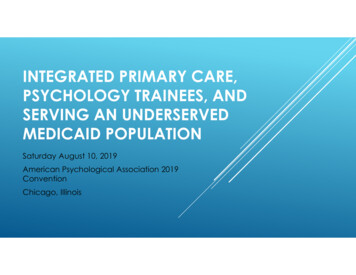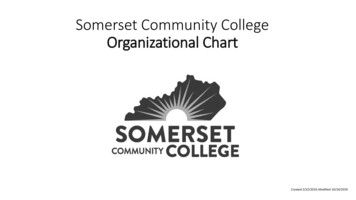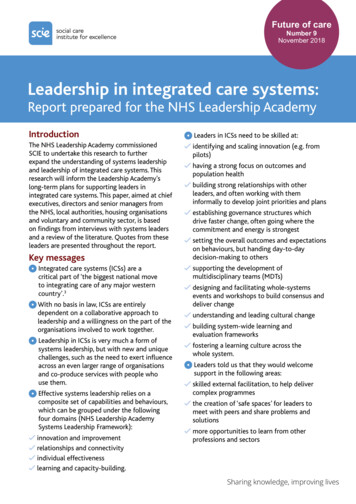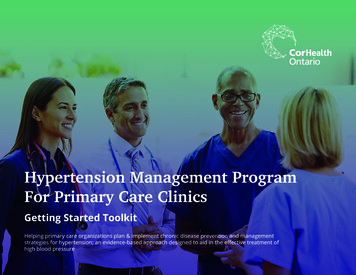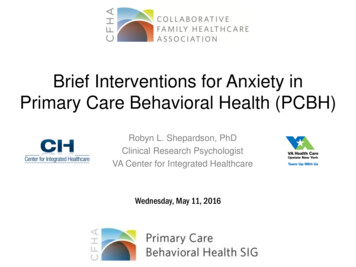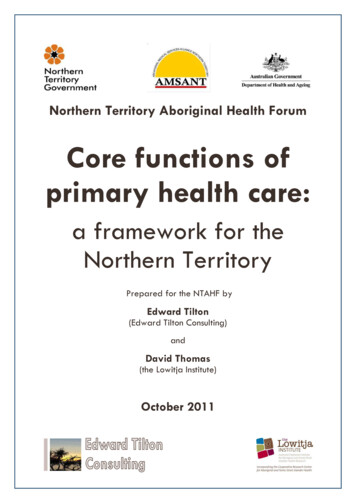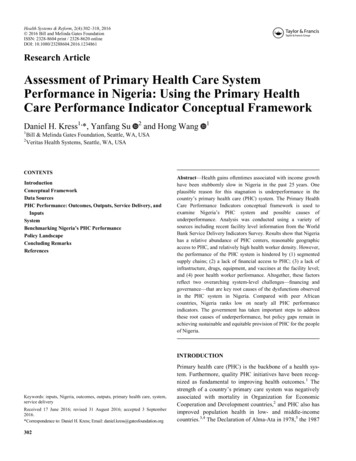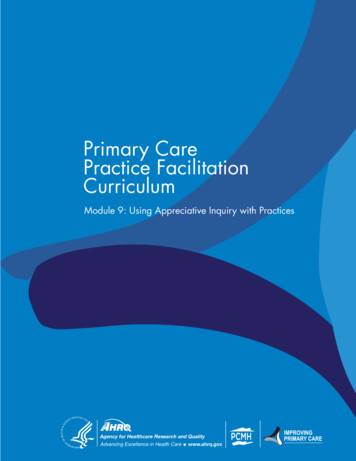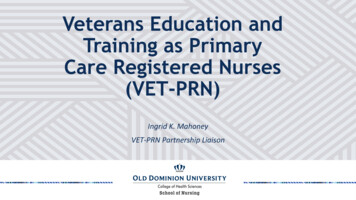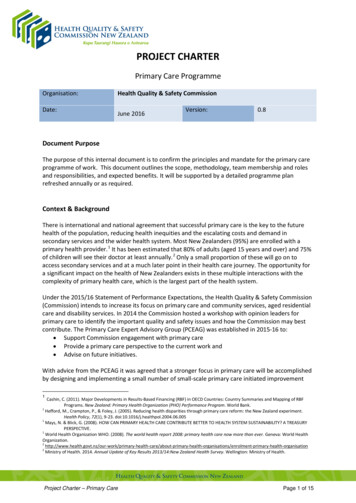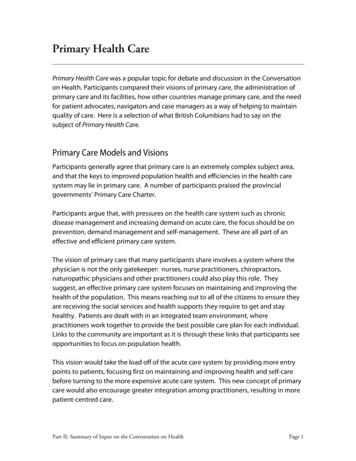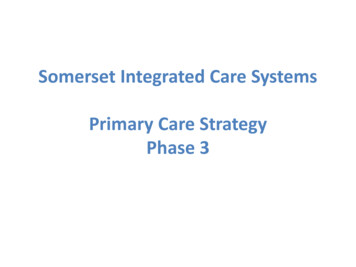
Transcription
Somerset Integrated Care SystemsPrimary Care StrategyPhase 3
Primary Care Strategy GPs are the first point of contact with the NHS for most people andthis strategy relates to those services provided by general practice. Other primary care providers include dentists, communitypharmacists and optometrists which are not directly commissionedby the CCG. 54 providers operating 65 practices 80% of urgent care provided by primary care each with differentsystems in place to deal with urgent care needs, routine care, andhome visits Increased demand from patients due to an aging population withincreasing complexity Primary care presentations being seen in other parts of the systemas unmet need flows through to Out Of Hours/acuteservices/Emergency Department Challenges in recruitment and retention of both GPs and primarycare staff locally and nationally affect both resilience and capacity
Primary Care Networks (PCNs) PCNs are key partners in the development ofintegrated care and expected to be the building blockswithin the system There are 13 PCNs with each network having allocatedfunding to support development of services and buildadditional capacity During Covid-19, PCNs have worked closely withneighbourhood teams made up of a range of localproviders including voluntary sector This has been exemplified by Enhanced Health in CareHomes (EHCH) work which was being supported byPCNs on a voluntary basis until it came in contractuallyfrom 31st July
PCNs and Neighbourhood TeamsIntegrated Health and Care TeamPCN extended primary careCore GP tc. 9,000 patients30,000- 80,000 patients30,000 – 80,000 patientsThrivingCommunities
PCN Directed Enhanced Service (DES)DES specifications for 20/21 include Enhanced Health in Care Homes,Structured Medication Reviews and Early Cancer Diagnosis and begincontractually in October 2020 and form the focus of the PCNs.Each PCN has an annual allocation of additional roles reimbursement scheme(ARRS) funding available for the recruitment of additional staff to supportdelivery of the PCN DES.There are currently 10 roles to choose from: Clinical Pharmacists & Pharmacy Technicians Social Prescribing Link Workers, Health & Wellbeing Coaches & Care Coordinators Physician Associates First Contact Physiotherapists, Dieticians, Podiatrists, OccupationalTherapists From April 2021 Paramedics and Mental Health Practitioners will be addedinto the scheme ARRs funding is drawn down nationally once the CCG has made paymentsagainst PCN claims Unspent monies do not come into Somerset and is lost to General Practice
Model For PCN workforceWe know from previous experience of health professionals working in Somerset practices that there are key rolesthat have contributed a significant impact on practice sustainability and patient experience. Their inclusion on theARRS list also highlights the importance of their role in delivering the PCN DES as their skills are inextricably linkedto the primary deliverables. We would recommend these as the core roles for PCNs to recruit with the remainingroles providing an enhanced skill mix.PCNs may substitutebetween ClinicalPharmacists, Physios &Physician l PharmacistPharmacy TechnicianHealth CoachFCP PhysioSocial PrescriberCommunity Paramedic*Care CoordinatorOccupational Therapist*reimbursement available Apr 2021MH Practitioner*PhysicianAssociatePharmacy Technicians arerestricted to one per PCN;other roles are not limited.6
Our existing priorities for primarycareWe have three clear priorities for primary care, agreed pre-covidbut still completely valid:
Forward not back Despite the challenges that Covid has brought, it has been a catalyst for truesystem workingDigital has been a key enabler with remote working and total triageDigital Multidisciplinary Teams (MDTs) have been implemented in many areas andexisting good practice strengthenedKey links have been made across the health and social care system as well as thevoluntary sectorOrganisational boundaries have become blurredCloser working with community and secondary care teams have supportedproactive and timely reactive responses to patients health and social care needs111 has supported triage of patients with Covid and local Clinical AssessmentService (CAS) has reduced the number of contacts to primary carePatients understand there is a need for them to access health and care supportdifferently going forwardBUT there is still much to do and the wider team are critical to a flourishingprimary care in its broadest sense
Challenges Primary Care is now seeing the results of the unmetneed of patients which have accumulated duringlockdown increasing workload Face to face appointments have been reduced andwhen they take place, are more time consumingbecause of Personal Protective Equipment (PPE) If Primary Care is unable to manage activity, because ofworkforce, capacity or the lack of resources closer tohome, there is a real risk that hospital activity willincrease to a level greater than that seen pre-Covid Covid demand is unpredictable
Enablers for primary careCultureCultureandandethosEthos10
Revised priorities for primary care inPhase 3In addition to continuing to deliver the existing priorities, we also need toprovide strong leadership in the following key areas:Ensuring that primary care can respond to continuing presence of Covid-19,including being able to respond to potential additional waves of Covid-19activity1. Ensuring there is equitable and timely access for all patientsappreciating the reduction in capacity resulting from PPE being worn,staff members self-isolating/shielding with demand being managedsafely and effectively2. Ensure that primary care can manage demand particularly over thewinter period3. Rapid implementation of Fit For My Future integrated out of hospitalcare model.These are described in more detail on the following slides.
Priority1:Ensuring that primary care can respond tocontinuing presence of Covid-19, includingability to respond to potential additional wavesThis means that: Primary Assessment Centres (diagnostic and treatment centres for Covid positiveor Covid likely patients) must continue to operate or be able to be mobilisedrapidly if needed Zoning of practice buildings or Primary Assessment Centres (PAC) sites within aPCN must continue Shielded patients need to be seen at home or managed safely within a separatezone if this is not possible Footfall in practices must be minimised to reduce potential spread of virus Continued use of PPE and face coverings for staff and patients Effective, consistent public messaging and patient information NHS support to care homes will continue to be a key focus
Priority 2Ensuring that routine demand can be metsafely and effectivelyThis means that: A digital first approach must remain the priority which includesoptimisation of triage services The shift of minor conditions to self-care, 111, community pharmacy andvoluntary sector must continue Optimising the role of the CAS in primary care Population health activities including screening, immunisations andvaccinations are vital and must continue Long-term condition management needs to return to pre-covid levels andevolve with wider integrated team involvement Primary Care in Somerset will ensure that those health inequalities thathave widened during the Covid pandemic, particularly seen within ourLearning Disabilty population are mitigated against by ensuring proactivemanagement through prioritising health checks and ensuring equitableaccess to primary care health services taking into account their needs System wide plan across providers (primary and secondary care) to ensurecapacity challenges not ‘shifted’ from one element to another without theassociated workforce or resources to deliver
Priority 3Rapid implementation of FFMF integrated outof hospital care modelThis means that: The integration and development of neighbourhood teamsis critical PCN development must continue and accelerate, toincrease the number of PCN new roles workers and fullyimplement the nationally set PCN priorities of cancerdiagnosis, structured medication reviews and enhancedhealth in care homes Promote prevention and self-care building on the widerneighbourhoods work We cannot underestimate the importance of the widerintegrated health and care team to include the communityservices teams such as District Nurses and the widerVoluntary Community and Social Enterprise (VCSE), to thesuccess of Primary Care and the system as a whole
System challenges1. Digital - digital innovations underpin all our key deliverables and include theability for us to communicate digitally with our patients and across our health andsocial care community as well us allow us to share information2. Integrated care – clear interlinks with commissioning approach and systemworking3. Urgent care - whole system approach needed, particularly in respect to winterincluding Clinical Assessment Service and Urgent Treatment Centres (UTCs)4. Elective care restart- need whole system approach5. Mental Health - increased incidence of mental health problems due to Covid thatneed to be addressed along side the pre-covid-19 levels seen6. Learning disabilities and other vulnerable groups - need to ensure serviceadjustments are made system wide to reduce the impact Covid-19 has had on thisgroup of patients and that adverse outcomes are mitigated against7. Women and children - need to respond to SEND (Special Educational needs andDisability), early intervention for “behaviours that challenge”8. Need to respond to the increased levels of domestic abuse and safeguarding thathave been seen during Covid-19 working more closely with the wider systembeyond health9. Advanced care planning and treatment escalation plans on an individualised basisto remain a high priority across the health and social care system10. Health inequalities are addressed countywide
Primary Care Challenges National guidance has at times been delayed ordifficult to interpret Digital innovations- challenges around videoconsultation platforms and future funding as well assoftware platforms to allow consultations to take placeacross practices and other parts of the health and caresystem Primary care workforce (clinical and non-clinical staff)health and wellbeing- currently low levels of sicknessbut appears to be increasing, many colleaguesexhausted Multiple concurrent priorities including flu and cancer
Risks-System-wide Test and Trace may have unintendedconsequences on system resilience CAS has not yet reached its full potential anddiscussions are happening at a PCN level butone size will not fit all Winter capacity and demand Many of the initiatives that have supportedprimary care in a proactive and timelyresponse are funded on an interim basis
Moving forward 3 clear priorities:1. Continue to respond to Covid-192. Provide comprehensive services3. Move forward with innovations Primary Care Cell continues to co-ordinate Constant focus on operational delivery
systems in place to deal with urgent care needs, routine care, and . integrated care and expected to be the building blocks . provide strong leadership in the following key areas: Ensuring that pri
